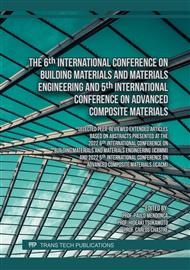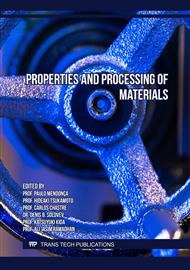[1]
(). Eurostat: Material flow accounts. Available: https://ec.europa.eu/eurostat/databrowser/view/ENV_AC_MFA__custom_987941/default/table?lang=en.
Google Scholar
[2]
A. M. Barrios et al, "Study of the properties of lime and cement mortars made from recycled ceramic aggregate and reinforced with fibers," Journal of Building Engineering, vol. 35, p.102097, 2021. Available: https://www.sciencedirect.com/science/article/pii/ S2352710220337293.
DOI: 10.1016/j.jobe.2020.102097
Google Scholar
[3]
M. Liikanen et al, "Construction and demolition waste as a raw material for wood polymer composites – Assessment of environmental impacts," J. Clean. Prod., vol. 225, pp.716-727, 2019. Available: https://www.sciencedirect.com/science/article/pii/S0959652619310649.
DOI: 10.1016/j.jclepro.2019.03.348
Google Scholar
[4]
E. F. Ledesma et al, "Maximum feasible use of recycled sand from construction and demolition waste for eco-mortar production – Part-I: ceramic masonry waste," J. Clean. Prod., vol. 87, pp.692-706, 2015. Available: https://www.sciencedirect.com/science/article/pii/ S0959652614011275.
DOI: 10.1016/j.jclepro.2014.10.084
Google Scholar
[5]
J. Dang et al, "Properties of mortar with waste clay bricks as fine aggregate," Constr. Build. Mater., vol. 166, pp.898-907, 2018. Available: https://www.sciencedirect.com/science/article/ pii/zS0950061818301326.
DOI: 10.1016/j.conbuildmat.2018.01.109
Google Scholar
[6]
M. Braga, J. de Brito and R. Veiga, "Incorporation of fine concrete aggregates in mortars," Constr. Build. Mater., vol. 36, pp.960-968, 2012. Available: https://www.sciencedirect.com/science/article/pii/S0950061812004230.
DOI: 10.1016/j.conbuildmat.2012.06.031
Google Scholar
[7]
A. Morón et al, "Experimental Study with Cement Mortars Made with Recycled Concrete Aggregate and Reinforced with Aramid Fibers," Applied Sciences, vol. 11, (17), p.7791, 2021. Available: https://search.proquest.com/docview/2570580613.
DOI: 10.3390/app11177791
Google Scholar
[8]
I. Raini et al, "Evaluation of mortar properties by combining concrete and brick wastes as fine aggregate," Case Studies in Construction Materials, vol. 13, pp. e00434, 2020. Available: https://www.sciencedirect.com/science/article/pii/S2214509520301066.
DOI: 10.1016/j.cscm.2020.e00434
Google Scholar
[9]
M. C. Limbachiya, E. Marrocchino and A. Koulouris, "Chemical–mineralogical characterisation of coarse recycled concrete aggregate," Waste Manage., vol. 27, (2), pp.201-208, 2007. Available: https://www.sciencedirect.com/science/article/pii/S0956053X06000201.
DOI: 10.1016/j.wasman.2006.01.005
Google Scholar
[10]
AEN/CTN 146, "UNE-EN 933-1: 2012 Ensayos para determinar las propiedades geométricas de los áridos. Parte 1: Determinación de la granulometría de las partículas. Método del tamizado," 2012.
DOI: 10.3989/mc.1974.v24.i156.1298
Google Scholar
[11]
AEN/CTN 146, "UNE-EN 13139 Áridos para morteros," 2003.
Google Scholar



